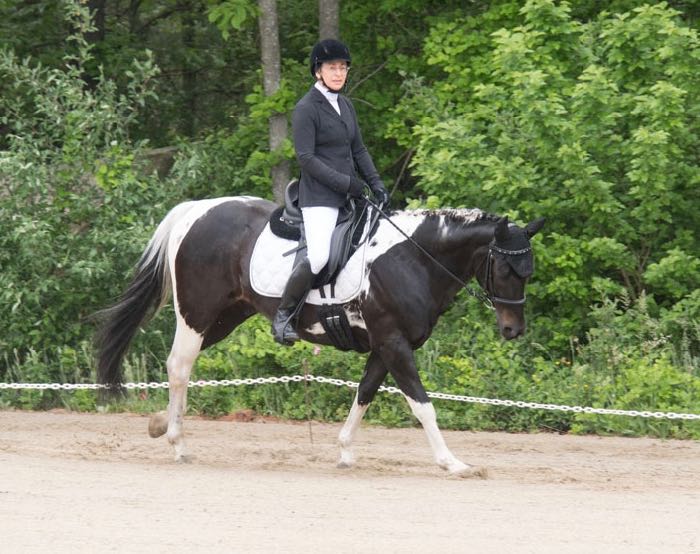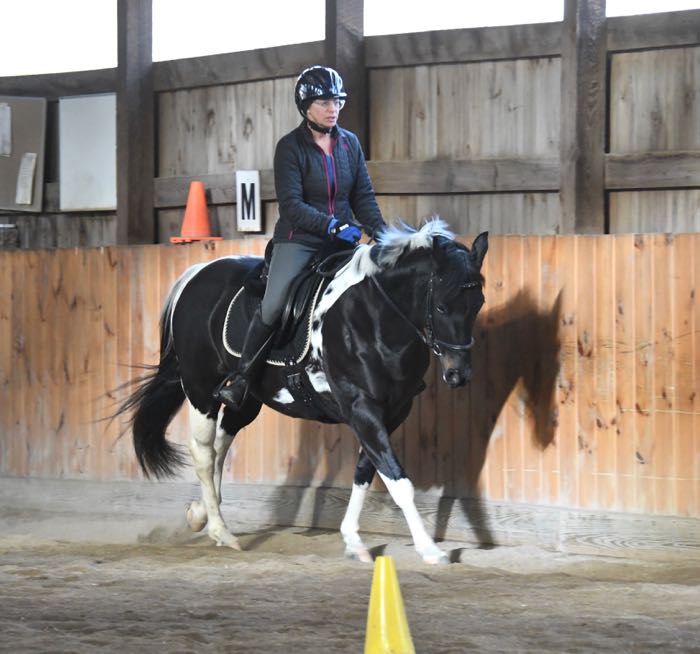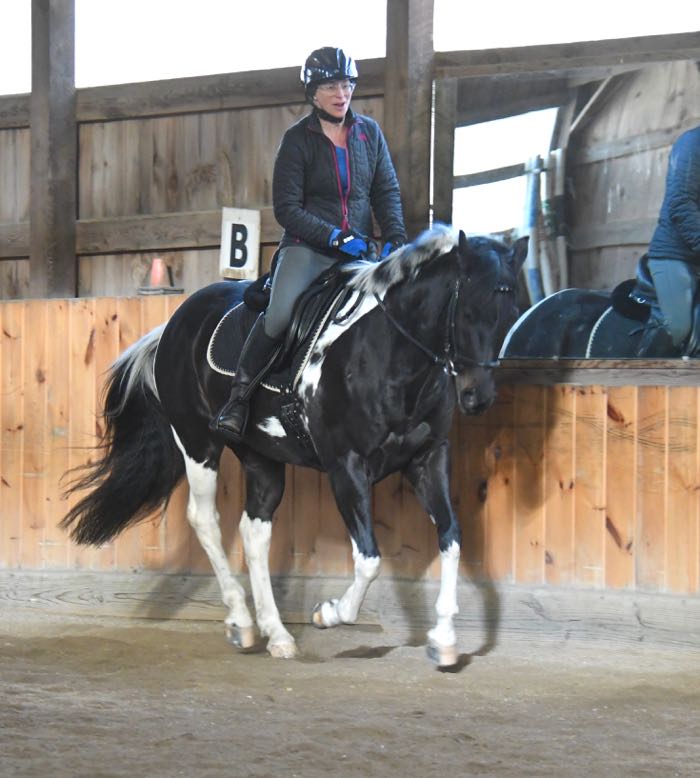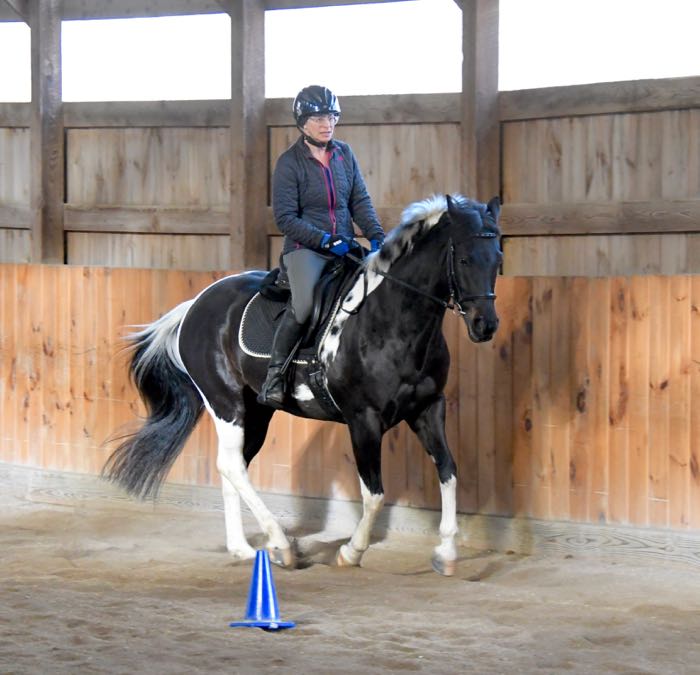This post goes on and on about small details that we dressage riders obsess over, like angles of the hock and suspension of a stride. But I hope that those of you not into such geeky horse things will stay with it, because this blogpost is actually about noticing the moment that you’ve asked for, letting the horse know Yes! That’s it! and rewarding him for it. Gratitude for the minutiae of life can transform how you see and live (and ride) the big picture.
Okay, enough pop-psychology – let’s talk riding.
This photo was taken 2 1/2 years ago. I had owned Tonka for only a few months, and had not yet ridden him much (the winter had been an icy deep freeze and there was no indoor ring) but I already knew that this was my forever heart horse.

I also knew that although he had a pleasant walk and a comfortable trot, that he didn’t have much of a canter. A canter is a three-beat gait, with one front leg that leads, and a moment of suspension when all legs are off of the ground. Tonka could not canter with the left leg leading, and to the right he’d peter out after about 5 strides. One reason that I started dressage with Tonka was to get him fit and balanced enough to carry himself so that he could canter with ease.
Tonka is built, my trainer (affectionately) says, like a hot dog. He’s also croup high, which means that at the canter he tends to head “downhill.” When I first started to address his canter issues, it was ok for him to heavy on the forehand, as long as he kept going! By last summer, Tonka was able to do a relaxed canter. Here we are warming up at a show. All around us were large fancy horses that naturally floated uphill. As we rode among them, I could have been frustrated that my little horse looked like he was going to dive headlong into the grass. But I remember that canter, how fluid and relaxed it felt, and I was grateful for our partnership and the work that it took to get to that point. I took that gratitude into the dressage ring.

Here we are riding the test. On this canter, the judge rightly gives us a mediocre 6.0 with the comment “too much on forehand.” I agree. But I was super-pleased with it because Tonka managed to canter all the way around, with a willing mindset and without breaking. That positive focus allowed me to ride the other figures of the test in a way that enabled Tonka to shine when he could. Our final score was 72.6, which placed us 2nd in a very competitive class.

As the summer progressed the canter scores increased to 6.5s and 7.0s. This came about because Tonka got stronger. I asked for the canter with classic seat and leg aids, but I added my own positive reinforcement spin to the training. I never drill. When Tonka offered a balanced canter stride, I’d mark the moment with a verbal “Dee!” bring him to a square halt and give him a cookie. In this way he knew exactly what we were striving for. Throughout the show season, our canter scores were good but not brilliant. To be brilliant, and to succeed at first level (which we aim for this spring,) Tonka needs jump.
We’re working on that now.
This photo was taken a couple of weeks ago. He’s more level than the photo from last summer, but there’s room for improvement. You can see how the left front hoof is flat on the ground, while the leg angles to the rear. That makes him spend too much time on his forehand. His right hind leg is pushing off from a straight stance and the left hind hock has little angulation. This is a canter that needs more jump.

I ask for it with a deep seat, closed legs and a more upright body. (Read my blog post about my own asymmetry. Tonka’s not the only one who has to get stronger!) Tonka tries harder. He pushes off the front leg more quickly, and bends his hocks. You can see me saying Good boy!

He knows he’s done well. He knows why. He keeps cantering. He gives me this.
There it is. His forehand is up. Tonka’s canter has jump.

I say Dee! and Tonka gets the promised reward. Look closely. He’s worked that hard for a tiny dinner mint.

Tonka is fine with that.
Actually, I believe that horses get a sense of satisfaction from feeling strong and fit, and from mastery of a skill. So, it’s not all about the peppermints, but treats do help me to communicate to Tonka, and cookies make him happy. I keep my pockets filled and I keep my eyes open for the moments that I can give them to him.



I’ve loved horses all my life but hardly ever ridden.
I love the smell of them, the sound of them, the feel of the soft hairs around the muzzle and the rough texture of the mane.
And I want to thank you and your gorgeous Tonka for the joys you share with us all. Regardless of our lack of expertise.
Thanks, Terry!
(I’ll be popping over to your ‘treats’ page later to top up the stash of mints etc for Tonka to enjoy! )
Tonka very much appreciates treats from him fans. He loves mints. He likes carrots, but likes apples even more. He tried celery the other day and after a quizzical face said he thought it quite tasty and crunchy! He does not like basil or other herbs. Carrot tops, though, are fine.
Lovely transformation being worked in an already lovely horse!
Thank you, Michelle. Very nice to hear that from another dressage rider 🙂
Another rider of “atypical” dressage partners – Paints, Morgan, Mustang. 😉
Timing on treats can be so difficult. (Coming frpm dog agility). We get so excited to get it ‘right’ that we often push right past that YES moment. Something I need to work on.
Timing is difficult to get right! With a fast agility dog, you can easily click too late. Also, as you note, pushing past that good moment is something we all have to steel ourselves not to do. Dressage riders often drill until the horse gets tired, so instead of rewarding the brilliant moment, they reward the slowing down. It’s very hard to stop when things are going well, but it’s necessary to get brilliance! Good for you to be so self-aware.
Terry, bit concerned watching girls for a while just now and one of the Marans I think poss Veronica seems to be struggling to get around. Seems very fluffed up, limping and stretching her neck and gaping a lot…. Great Tonka blog as usual and don’t care how much you go on to get point across!!
I agree with Jan, I don’t care how much you go on to get the point across. Even though I ride western and mostly trail ride, there is always something to learn and apply to whatever style of riding you are doing. It’s always good to keep an open mind for whatever you are doing, horses, dogs, whatever I think. I always feel good when whatever you might say is something I am doing already.
Trail riding, while connected and in empathy with your horse, is as challenging and fulfilling as any riding “sport.” Sounds like that’s what you do (and I think you are doing it in some spectacular scenery!)
Like Tonka, my horse is a Paint and a “hot dog”. When he canters I feel as if I am on a trampoline and will at any moment be catapulted over his head. I thought this was entirely due to my less-than-stellar riding skills. Thanks to your post, I’m glad to know it is only partially my fault!
The more balanced the horse is, the easier to sit. But it’s a catch-22, because the more balanced the rider is, the more balanced the horse… A good riding instructor will set up exercises in which both horse and rider succeed. I recently taught a student whose horse ran into and got strung out at the canter transition. Using a pole on the ground on a 20 m circle, and a carefully timed cue, they both succeeded 🙂
You two…definitely a love match. Definitely!
Yep 🙂
I found this latest post so interesting! My 17 year old Tennesee Walker is working on his canter as well. In the two years since I’ve owned him we have been able to develop a nice working trot as opposed to a running walk, and now we are working on his canter. Right now he is able to canter for maybe 5 or 6 strides on the left lead, but he is much stronger on the right lead. We have found that lunge line work is super helpful, and dressage training of course. I am so thankful to have a trainer who gives us just as much consideration and kudos that she gives her upper level riders. I am also so blessed to have these upper level riders come in and applaud Booker’s trot like he was a Grand Prix horse!
It sounds like to have the perfect horse for you, and the perfect trainer and group of barn friends. I love hearing that!
Interesting to me the post about teaching the TWH to trot instead of runwalk. I ride gaited horses, and we do our best to keep them runwalking or foxtrotting and not do a regular trot. I imagine her TWH does look quite striking doing a working trot, they carry themselves so well usually. I do lope (canter) my gaited horses whenever the footing is good for that, a lot of the gaited horse people around here don’t think they should do that, but it only builds up different muscles and makes them more rounded in my opinion. It only goes to show you how versatile horses are no matter the breed. My Standardbred did great rollbacks and spins, (needless to say I rode Quarter Horses most of my life) and did a wonderful runwalk, and could beat almost any horse at a rack.